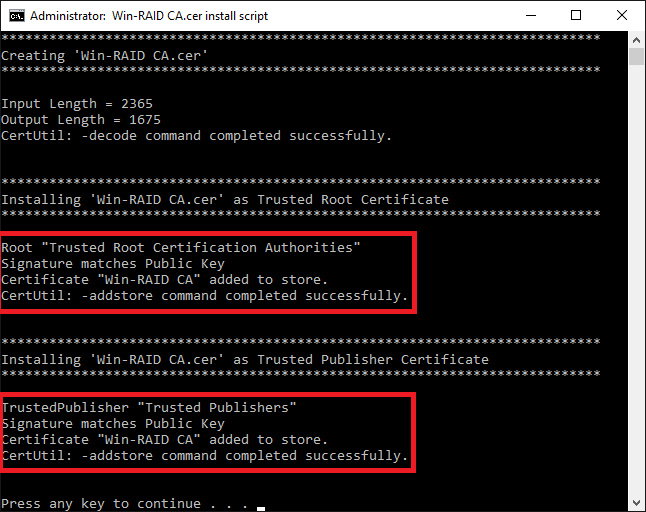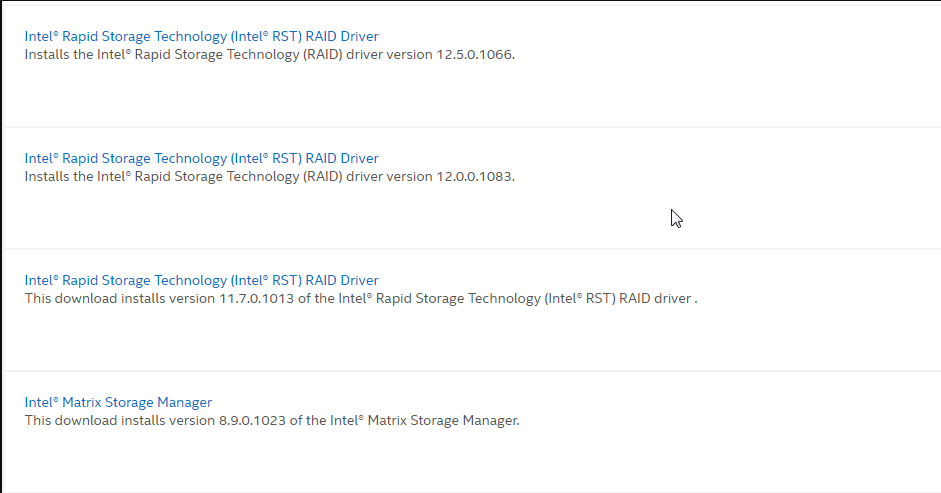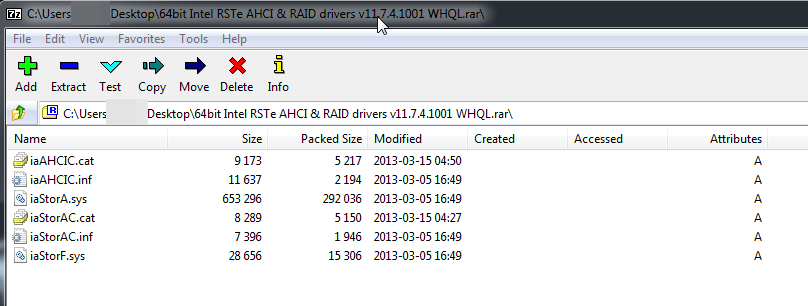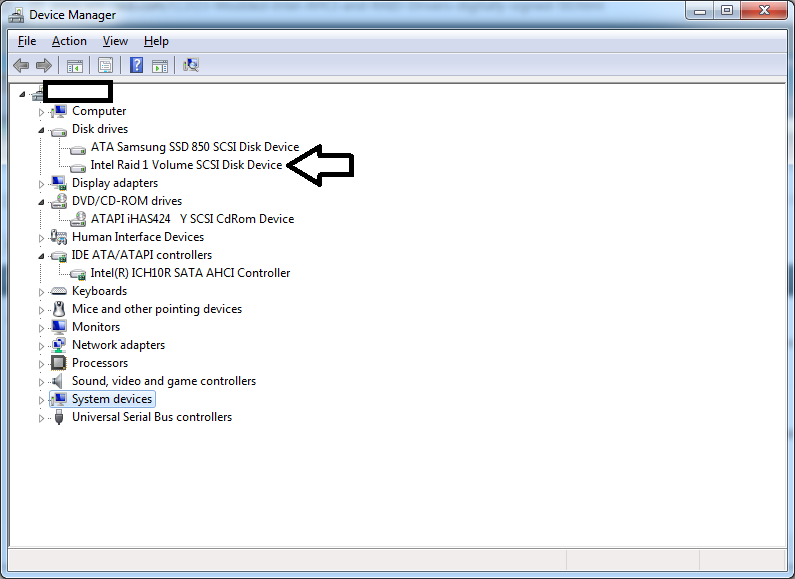@ms178 :
I forgot to mention the following, which I have appended in the original post: The current setup is a 1TB EVO 850 as the boot drive running in AHCI mode and 2 separate, independent internal HDDs also running in AHCI. The 2 HDDs used to be run in a RAID1 configuration some time ago, but something happened and the array stopped working (not exactly sure the details, it’s my dad’s computer I’m working on).
Going forward, I intend to use the SSD as the primary boot drive, leave 1 HDD unconnected, and use the other HDD as a backup location.
EDIT by Fernando: Fully quoted post removed and replaced by direct addressing to the author (to save space within this voluminous thread)
@Faizun912 :
Welcome at Win-RAID Forum!
Yes, this is the Intel RST(e) driver versiion, which I recommend to use for users with an Intel ICH10R Southbridge running in AHCI mode (look >here<), but why don’t you use the original v11.7.4.1001 WHQL driver? They do natively support Intel ICH10R SATA AHCI Controllers.
Regards
Dieter (alias Fernando)
@ms178 :
No, I haven’t yet received any report from Win10 users, who had difficulties to get any of my mod+signed Intel AHCI/RAID drivers properly installed.
Which sort of problem did you detect?
EDIT:
Since I am already running the final Build of Win10 v1703, I just have tested to import the Win-RAID CA Certificate and succeeded, as you can see here:

@Faizun912 :
The only official drivers I see are these:

which are not v11.7.4.1001. Am I looking in the wrong place? I previously had v11.7.0.1013 installed (drivers and RST application) which caused many problems with the HDDs.
@Faizun912 :
I haven’t written about drivers, which are offered at Intel’s Download Center.
Please re-read my last post and follow the link. At the bottom of the start post you will find a table, where I have listed the Intel AHCI/RAID drivers I recommend to use for the different Intel Chipsets resp. Southbridges.
Nevertheless you can try any other Intel AHCI driver version.
Have you written to yourself?
EDIT: If you are searching for a download link to the Intel RST(e) AHCI/RAID drivers v11.7.4.1001 WHQL, I recommend to do a look into the start post of >this< thread.
@Fernando :
Haha, it would appear that I have accidentally done that.
What I’m confused with is that you said to try the original v11.7.4.1001 WHQL driver, but I cannot locate this driver anywhere. The only version of that driver I can find is the one that is modded+signed by yourself located in this thread.
EDIT: Just saw your edit. I’ll take a look through that thread.
You can find the link at the end of my last post.
Not needed - just the start post!
@Fernando :
I believe I found the correct drivers:

2 follow-up questions:
1. In your opinion, have I sufficiently uninstalled the previous version as to not cause issues?
2. With this new driver, the procedure would be as follows: Device Manager → IDE ATA/ATAPI controllers → Right click on Intel ICH10 Family 6 Port SATA AHCI Controller - 3A22 → Manually direct the update to the new driver folder?
EDIT by Fernando: Actually not important and much too big image resized (to save space)
@Fernando
Silly me. Sorry for the noise, I totally forgot about the first time CA-Certificate installation (and ended up installing them with disabling driver enforcement). I am also running the final Win 10 v 1703 build. I’ll test it tomorrow but as it is running fine for you this must have been a problem on my end. ![]()
@Faizun912 :
If you should have already installed the mod+signed Intel RST(e) drivers v11.7.4.1001, there is no reason to replace them by the WHQL stamped ones.
The function and the performance of the drivers are identical.
@Fernando :
I have not re-installed any Intel RST drivers. My current configuration is still as it is in post #739.
@Faizun912 :
And which is your problem now?
Do you need a guide about how to manually install a WHQL certified driver from within the Device Manager?
@Fernando :
Just wondering if I’m OK to manually install the new driver given that I had previously installed and then uninstalled v11.7.0.1013. Just want to make sure there are no problems when I install v11.7.4.1001.
@Faizun912 :
As long as you haven’t installed any complete Intel RST/RST(e) Drivers & Software Set, you can manually change the Intel RST/RST(e) driver without any problem.
Note: You should not try to delete the previously installed driver from within the C:\Windows\System32\Drivers folder and not delete the related entries within the registry. The “old” drivers and their registry entries are required for the OS for the emergency case and shown as “compatible” within the Device Manager, when you are going to change the driver and choose the option “Let me pick…”.
Important: The presence of the formerly used drivers within the Windows\System32\Drivers folder and their related registry entries have no negative impact on the system and on the functionality of the on-board Intel SATA Controller and its freshly installed driver.
If you want to know, which driver(s) is/are currently in use by any device (here: Intel SATA AHCI or RAID Controller), just enter the Device Manager, do a right-click onto it and choose the options “Properties” > “Driver” > “Driver Details”.
@Fernando :
I did install the entire driver and software set for that version. However, I uninstalled the console part from the control panel and I believe that reverted the drivers back to the msachi controllers.
I think I’m good to go on installing the new drivers then. I’ll give them a go and report any problems, if any.
@Fernando :
So I installed the driver and everything seems OK (I’ll bench it later), however, it is showing my singular HDD now as a RAID1 disk instead of a singular ATA device. Any idea why that may be?

I suspect, that you forgot to delete the RAID array, when you decided to use it as non-RAID member HDD.
The related entries are still on the track0 of the Disk drive.
@Fernando :
Would a reformat of the drive fix this issue or would I have to connect the other drive, install the full RST software, and delete the array from there (or via the controller during POST)?
No, the track0, which contains the RAID array entries, will not be erased by a simple formatting.
The easiest way would be to temporarily reconnect both HDDs, which were members of the RAID array, to set the SATA mode of the Intel SATA Controller to “RAID” within the BIOS, to hit CTRL+I while booting and then to delete the RAID array (no matter, whether it is shown as healthy or degraded).
After having done that, you can restore your current system configuration.
Very important: Backup all your important data, which are currently on both HDDs, before you delete the RAID array.